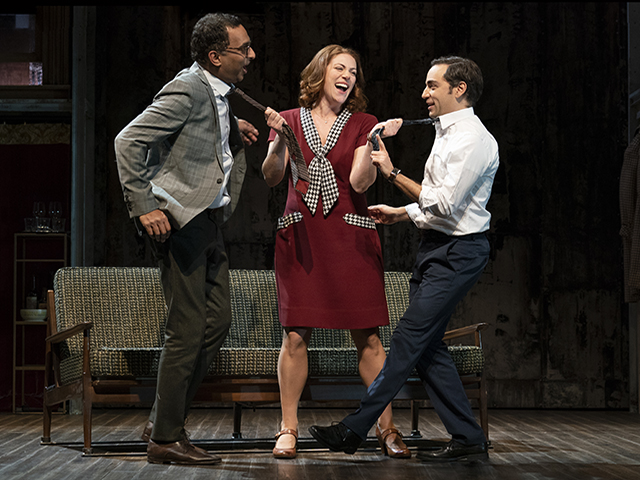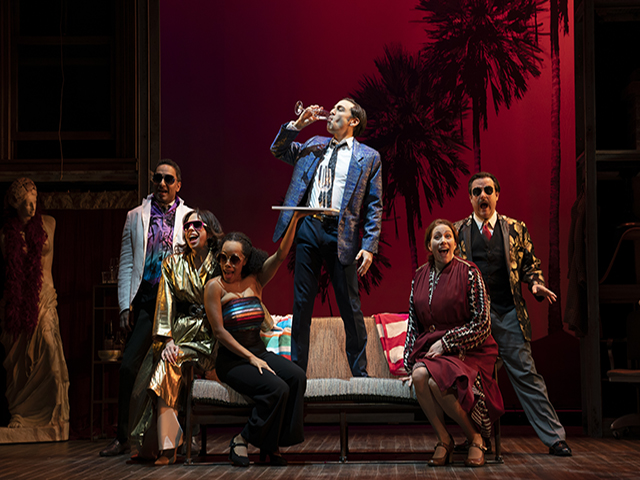
Merrily We Roll Along goes backward to tell the story of three old friends bursting with dreams (photo by Joan Marcus)
Laura Pels Theatre
Harold and Miriam Steinberg Center for Theatre
111 West 46th St. between Sixth & Seventh Aves.
Tuesday – Sunday through April 12, $109
212-719-1300
www.roundabouttheatre.org
www.fiascotheater.com
Ever since it famously flopped on Broadway in 1981, Stephen Sondheim and George Furth’s Merrily We Roll Along has gone through numerous iterations; the show has a beloved score but a challenging narrative. As part of its Roundabout residency, New York–based Fiasco Theater, who delivered a gorgeous Into the Woods at the Laura Pels in 2015 — in addition to several unique takes on Shakespeare at Theater for a New Audience, Classic Stage, and the New Victory in the last few years — now tackles Merrily, but not even this extremely talented company can get past the fatal flaws of the plot. Working in elements from the 1981, 1987, and 1994 versions, including rehearsal drafts, along with the original 1934 play by George S. Kaufman and Moss Hart on which the musical is based, Fiasco has trimmed the play down to its essentials, but there’s still not much meat on the bones. The story begins in 1980, with the six-actor ensemble singing, “Yesterday is done, / See the pretty countryside / Merrily we roll along, roll along, / Bursting with dreams.” The action then travels back in time, through the 1970s, ’60s, and ’50s, following three main characters — Franklin Shepard (Ben Steinfeld), Mary Flynn (Jessie Austrian), and Charley Kringus (Manu Narayan) — as they reverse their development from jaded, unhappy adults to energetic teens “bursting with dreams.”

Fiasco Theater tries to wrap its arms around elusive Sondheim/Furth musical at the Laura Pels (photo by Joan Marcus)
The main problem is that none of the three characters in this tale of friendship, betrayal, and selling out is particularly likable, so their personal trials and tribulations are just not that interesting. Frank is a narcissistic movie producer and musical theater composer who has difficulty remaining faithful to his wives or Charley, his songwriting partner, while Mary burned herself out on her debut novel. Also making the scene are Frank and Charley’s producer, Joe (Paul L. Coffey), and his wife, Gussie (Emily Young); their early supporters the Spencers (again, Coffey and Young); Frank’s first wife, Beth (Brittany Bradford); and Meg (also played by Bradford), the star of Frank’s debut movie. Derek McLane’s set is meant to evoke the backstage area of the Alvin Theatre on Broadway, where the show opened on November 16, 1981, and closed on November 28, after forty-four previews and only sixteen performances. Merrily is very much insider theater, and the set makes that plain, with rows and rows of props, from masks and lamps to cameras and bottles, that reach up to the ceiling, while Paloma Young’s costumes are hung up at floor level, allowing the actors to make quick changes as necessary.
A Fiasco tradition, the cast members who are not involved in the action often sit on the side, watching the proceedings with the audience. The orchestrations and new arrangements by Alexander Gemignani — whose father, Paul Gemignani, was the music director for the show’s brief Broadway tenure — are rather basic and standard; songs such as “Old Friends,” “Not a Day Goes By,” “It’s a Hit,” and “Our Time” need much more nuance and oomph, especially since the vocal chops of the cast are inconsistent. Director Noah Brody (Into the Woods, Measure for Measure) can’t quite get it all to flow together, merrily or not. “Why can’t it be like it was? / I liked it the way that it was,” Mary sings early on. But looking back — and going into the past — is not always the best answer, in real life or in fiction.